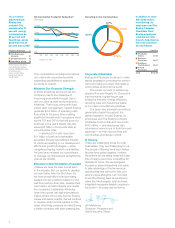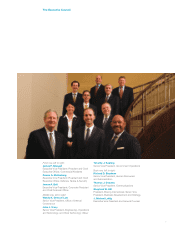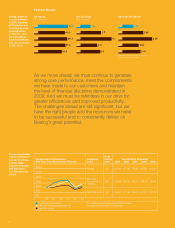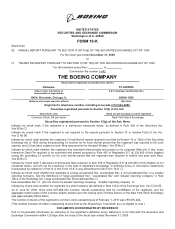Boeing 2009 Annual Report Download - page 18
Download and view the complete annual report
Please find page 18 of the 2009 Boeing annual report below. You can navigate through the pages in the report by either clicking on the pages listed below, or by using the keyword search tool below to find specific information within the annual report.Forward-Looking Statements
This report, as well as our Annual Report to Shareholders, quarterly reports, press releases and other
written and oral communications, contains “forward-looking statements” within the meaning of the
Private Securities Litigation Reform Act of 1995. Words such as “may,” “will,” “should,” “expects,”
“intends,” “projects,” “believes,” “estimates,” “targets,” “anticipates” and similar expressions are used to
identify these forward-looking statements. Forward-looking statements include any statement that does
not directly relate to any historical or current fact.
Forward-looking statements are based on our current expectations and assumptions, which may not
prove to be accurate. These statements are not guarantees and are subject to risks, uncertainties and
changes in circumstances that are difficult to predict. Many factors, including those set forth in the
“Risk Factors” section below, could cause actual results to differ materially and adversely from these
forward-looking statements. Any forward-looking statement herein speaks only as of the date on which
it is made, and we assume no obligation to publicly update any forward-looking statement, except as
required by law.
Item 1A. Risk Factors
An investment in our common stock or debt securities involves risks and uncertainties and our actual
results and future trends may differ materially from our past performance due to a variety of factors
including, without limitation, the following:
We depend heavily upon commercial airline customers, our suppliers and the worldwide
market, which are subject to unique risks.
We derive a significant portion of our revenues from a limited number of major commercial airlines,
some of which have encountered financial difficulties. We can make no assurance that any customer
will purchase additional products or services from us after our contract with the customer ends. In
addition, financial difficulties, including bankruptcy, of any of the major commercial airlines could
significantly reduce our revenues, even under existing contracts, and limit our opportunity to
generate profits from those customers. Several commercial airlines, including certain of our
customers, have filed for or emerged from bankruptcy protection.
Our ability to deliver aircraft on time depends on a variety of factors, which are subject to unique
risks. Our ability to deliver jet aircraft on schedule is dependent upon a variety of factors, including
execution of internal performance plans, availability of raw materials (such as aluminum, titanium
and composites) and internally and supplier produced parts and structures, conversion of raw
materials into parts and assemblies, performance of suppliers and subcontractors and regulatory
certification. The failure of any or all of these factors could result in significant out-of-sequence work
and disrupted process flows adversely affect production schedules and program/contract profitability,
the latter through increased costs as well as possible customer and/or supplier claims or assertions.
In addition, the introduction of new commercial aircraft programs and major derivative aircraft
involves increased risk associated with meeting development, production and certification schedules.
For example, recent modifications required on the side-of-body section of our 787 aircraft have
resulted in testing and delivery delays.
Market conditions have a significant impact on our ability to sell aircraft into the future. The
worldwide market for commercial jet aircraft is predominantly driven by long-term trends in airline
passenger and cargo traffic. The principal factors underlying long-term traffic growth are sustained
economic growth and political stability, both in developed and emerging countries. Demand for our
commercial aircraft is further influenced by airline industry profitability, world trade policies,
government-to-government relations, terrorism, disease outbreaks, environmental constraints
imposed upon aircraft operations, technological changes and price and other competitive factors.
6
























